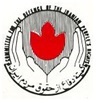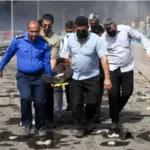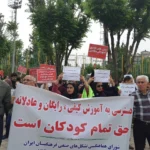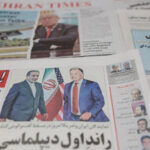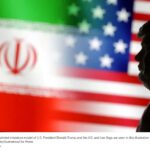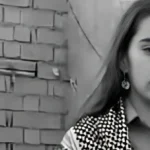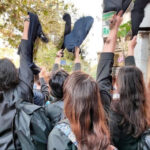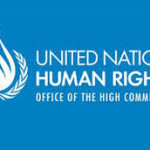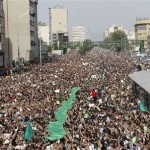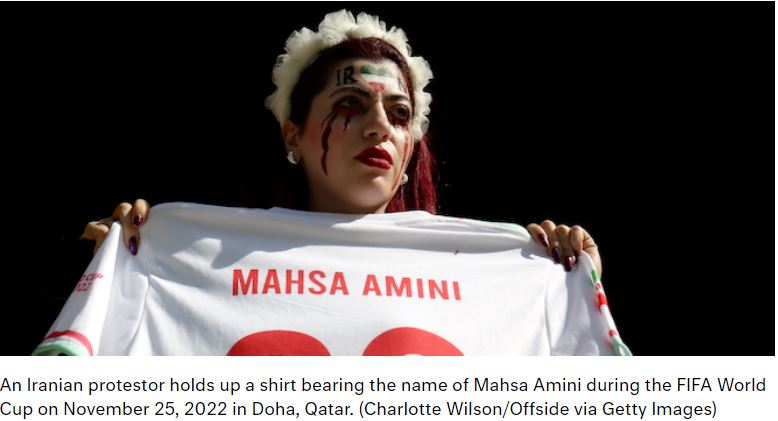
The massive protests in Iran, fueled by the audacity of young women and children, are rooted in over a century of struggle.
Janet Afary and Kevin B. Anderson
December 2, 2022
This article will appear in Dissent‘s Winter 2023 issue, out in January. To get your copy, subscribe now.
In March, 1979, urban Iranian women and girls and their male supporters took part in a week of demonstrations in Tehran, beginning on International Women’s Day, to protest the new Islamist regime’s edict compelling women to wear hijabs. The demonstrators expressed a deep sense of betrayal at the direction being taken by the Iranian revolution, then just weeks old. “In the dawn of freedom, we have no freedom,” they chanted. Their ranks grew by the day, reaching at least 50,000. The movement attracted international solidarity, including from Kate Millet, who famously traveled to join them, and Simone de Beauvoir. At home, Iranian feminists gained support from the People’s Fedayeen, a Marxist-Leninist group which had engaged in armed resistance against the American-backed monarchy before it was overthrown by the revolution. For a few days, the Fedayeen formed a protective cordon, separating the protesters from crowds of Islamists who were trying to physically attack them. But in time, influenced by a visiting Yasser Arafat and others, the Fedayeen withdrew its support for fear of weakening the revolution at a time when, it was widely believed, the U.S. government was ready to pounce and restore the shah. Over the next few years, the Iranian feminist movement seemed to die, or at least go underground.
More than forty years later Mahsa (Jina) Amini, a twenty-two-year-old Kurdish woman, arrived in Tehran with her family on vacation. Soon after, on September 13, 2022, agents of the country’s infamous morality police arrested her on charges of wearing her hijab improperly. Despite her vigorous protestations, they took her into custody, whereupon, according to eyewitnesses, she was severely beaten. Three days later, she died from brain injuries. Amini’s death struck a nerve throughout the nation. The state’s refusal to look into the causes of her death, or to offer an apology, further fanned the anger of protesters. Demonstrators soon began to chant, “Don’t be scared, don’t be scared, we are all together.”
Demonstrations have taken place in more than eighty cities and towns throughout the entire country. As the protests have spread, young women, even high-school and middle-school students, have ripped off their headscarves and cried, “Death to the dictator!” The uprising is rooted in red-hot anger against gender apartheid, and not only among women. As the renowned actress Golshifteh Farahani told Le Monde, what has made these protests historically novel is that “men are willing to die for women’s freedom.”
Demographically, Iran, with a population of 85 million, is a very different country than what it was in 1979. Fully 75 percent of the country is urbanized, literacy stands at almost 100 percent among people under twenty-five, and there are 4 million university students, the majority of whom are women. Meanwhile, the fertility rate has fallen to 2.1 births per woman, from 6.5 in 1979.
Many issues besides women’s rights are bound up in the protests: authoritarianism, economic stagnation and severe unemployment, climate disaster, and various religious-fundamentalist impositions. The current uprising also represents the public’s response to the regime’s colossal cronyism and corruption, and to its confrontational foreign policy and regional expansionism, which have isolated Iran and contributed to extremely high inflation in the country. These grievances have fueled other protests over the past few years, but the 2022 uprising is also distinguished by an ethnic dimension: Mahsa Amini was from Iranian Kurdistan, an impoverished, marginalized area with a long history of revolutionary resistance. When she was born, her family had wanted to give her a Kurdish name, Jina, but the policies of the Islamic Republic restricted their choices to Persian and Arabic names. In Kurdistan, the 2022 uprising has taken over whole towns—and the regime has not hesitated to use live ammunition against the protesters. Many also believe that Mahsa Amini was singled out by the morality police of Tehran because she was dressed as a Kurd.
Decades of ethnic oppression also fueled protests in Sistan and Baluchestan, a southeastern region that borders Pakistan. After demonstrators came out in Zahedan to protest the reported rape of a local girl by a police official, the regime responded with gunfire on September 30, 2022. Police chased demonstrators off the streets, firing live ammunition into a Sunni mosque during worship services. The violence resulted in at least ninety-three deaths, soon known as the Zahedan Massacre. This has led to widespread and continuing protests in the region, supported by the highest-ranking cleric of the province, the Sunni imam Mowlavi Abdulhamid, who is known for supporting the Reformist wing of the regime. These events, which show a connection between movements against gender oppression and against ethno-national oppression, point to the deeply intersectional character of the 2022 uprising. Various professional and artistic groups—including actors, lawyers, doctors, nurses, teachers, professors, and even some past and present members of the national soccer team—have expressed solidarity with the protests.
The uprising has continued with particular force in Iranian Kurdistan, with the city of Sanandaj playing a central role. (Kurdish leaders in Iraq and Syria also condemned Amini’s killing.) By October, regime forces using live ammunition were storming the city, firing machine guns indiscriminately at protesters, rampaging through people’s homes, and even shooting to death a man who had simply honked his car horn in solidarity with protesters. Kurdistan, especially Sanandaj, Mahabad, and Amini’s hometown Saghez took center stage again in late October, when vast crowds from all over the country converged to mark the forty-day anniversary of Amini’s death, a centuries-old custom followed by all Muslim communities in Iran. The state tried to stir up fear and dissuade people from gathering by saying a shooting at the religious shrine of Shah Cheraq in Shiraz (the second holiest shrine in Iran) was “an attack by ISIS.” But no one seemed to believe the government’s account, and protesters responded with chants like “You are our ISIS.” The police also tried to block the outpouring, but to no avail. They opened fire at one point and killed some of the mourners. A nationwide general strike was also called for that day, with scattered success.
In Tehran’s Evin Prison, where thousands of protesters are being held, a fire broke out in late October that could be seen throughout the entire city. It’s not clear what led to the fire, but it might have been started by guards in an attempt to silence prisoners who chant in solidarity with the protesters inside the gates. By November, the bazaars were shutting down as protests continued nonstop, with the largest strikes in Tehran and Kurdistan. The ancestral home of regime founder Ayatollah Ruhollah Khomeini was torched.
The uprising has been fueled by the audacity of young women and children, and they have experienced the regime’s brutal response. A commander of the Revolutionary Guards revealed in September that the average age of detained protesters was only fifteen. Sixteen-year-old Nika Shahkarami was arrested after taking off her hijab and setting it on fire at a protest in Tehran in September, and she died soon after in police custody. Sarina Esmailzadeh, also sixteen, was beaten severely by police at a September protest in Karaj, an industrial suburb of Tehran, and later died in a police station. In October, Asra Panahi—another sixteen-year-old—was bludgeoned to death by police after she disrupted a pro-regime ceremony at her school in Ardabil, in Iranian Azerbaijan. In November, a nine-year-old boy named Kian Pirfalak was reportedly killed by security forces in the southern province of Khuzestan. His death further galvanized the protests and turned him into a new icon of the movement, representing hundreds of children who have been arrested or murdered. The public became almost inconsolable when it became known that the young boy was progressive and had used a secular invocation, “to the God of the Rainbows” in a school project, in a departure from religious orthodoxy.
The protests have featured young women standing up before crowds, baring their heads, and then cutting off their hair in an act of defiance—and in a revival of a cultural practice of women cutting their hair in mourning, which goes back as far as the eleventh-century founding text of Persian literature, the Shahnameh. The movement has also developed its own anthem, “Baraye” (“For the Sake of”). Written by singer Shervin Hajipour, it is played and sung constantly throughout Iran and in diaspora communities. The lyrics say:
For the fear of dancing in the alleys
For fear at the moment of kissing
For my sister, your sister, our sisters
For changing rusted minds, for the shame of poverty
For the wish to live a normal life
For the dumpster-dwelling children and their wishes
For this dictatorial economy
For this polluted air
For the worn-out plane trees on Vali ‘Asr Street
For the cheetah and its possible extinction
For the innocent banned stray dogs
For the unstoppable tears
For repeating this moment
For smiling faces
For students and their future
For this compulsory paradise
For the imprisoned elite students
For the Afghan kids
For all these “fors” that are beyond repetition
For all these meaningless slogans
For all the collapsed, shoddy buildings
For the feeling of peace
For the sun after a long night
For sleeping pills and insomnia
For man, homeland, prosperity
For the girl who wished to be a boy
For woman, life, freedom
For freedom, for freedom, for freedom
While the uprising has been leaderless so far, it has not been aimless or incoherent. Its slogans indicate the movement’s general aspirations. The most prominent one, “Woman, Life, Freedom,” not only places women’s emancipation at the center but also evokes transformative change: it originated in the Rojava region of Syria, where Kurdish forces, some commanded by women, drove out the Islamic State in late 2017. It is incredibly moving to hear demonstrators in Tehran, who are largely from the dominant Persian community, shouting out a slogan that originated in Kurdistan. Usually they shout it in Persian, but sometimes, in a further act of solidarity, they use Kurdish.
“Death to the dictator,” the movement’s other primary slogan, began to emerge in 2019. It marks a clear break with the tenor of the massive Green Movement of 2009–10, which had a clear leadership that channeled the movement into demands for the democratization of the Islamic Republic, not its overthrow. Echoing the most prominent slogan of the 1979 revolution, “Death to the Shah,” the 2022 version refers instead to Supreme Religious Leader Ali Khamenei. (A popular variant of this slogan—“Death to the oppressor, whether Shah or Rahbar [supreme religious leader]”—suggests opposition to efforts by some conservatives in the diaspora to restore the monarchy in the person of Reza Pahlavi, the son of the late shah.) The slogan is particularly risky because Khamenei is, in the legal terms of Iran’s theocracy, God’s representative on Earth; even verbal attacks on him could be subject to a law that makes “rebellion against God” a capital offense. Another slogan underlines the depth of popular anger: “This is the year of blood. Seyyed Ali [Khamenei] will be overthrown.”
Context of the Current Uprising
The current unrest broke out in the wake of several smaller uprisings over the past several years. In 2017, young women began a series of anti-hijab protests in which they posted selfies on social media that showed them unveiling in public. In September 2019, a young woman, Sahar Khodayari, died after setting herself on fire to protest a prohibition on women attending soccer matches. Later in 2019 and in 2020, demonstrations over gasoline prices grew into nationwide anti-government protests concentrated in smaller cities and rural areas. However, these two types of protests, one prompted by gender apartheid and the other stemming from economic grievances, remained largely separate.
As protests subsided somewhat during the COVID-19 pandemic, the regime engineered the 2021 election of President Ebrahim Raisi, a far-right figure who was directly involved in the execution of thousands of Iranian political prisoners in 1988 and previously served as the country’s chief justice. Soon after, a crackdown began. In the summer of 2022, the government bulldozed homes in a village inhabited for more than a century by members of the Bahá’í religious minority. During those same months, the morality police escalated attacks on young women for “improper hijab,” accusing them of insufficiently covering their hair or other body areas. It was this phase of repression that took the life of Mahsa Amini.
Some believe that the regime might loosen hijab regulations and evolve toward a more “normal” military dictatorship under the Islamic Revolutionary Guards Corps. Gender subordination has been woven into the fiber of this regime ever since 1979. Supreme Leader Khamenei, who has held the position since 1989, is in declining health, which also presents a crisis for the regime. If the officials orchestrating the current repression are hesitant in pursuing a full crackdown, as recent hacking of state communication has revealed, it is because they don’t want to be left holding the bag when new leadership comes to power—in case that leadership is eager to use particularly odious officials as scapegoats while claiming, however fraudulently, that a new era will involve more listening to the people.
In addition to chafing under religious restrictions, middle- and working-class Iranians have seen their standard of living drastically drop over the past decade. The country has faced skyrocketing prices and housing costs and high unemployment. By early October, labor groups, including some in the strategic oil sector, had begun to take a prominent role in the protests. At the turn of the twenty-first century, high oil prices briefly allowed the government to spend more on domestic social programs. In recent years, however, growing internal consumption, aging production facilities, and U.S.-imposed sanctions have limited Iran’s capacity to export oil. Moreover, oil-funded state expenditures contributed little to economic development, let alone job creation.
U.S. sanctions, which were reimposed during the presidency of Donald Trump, greatly increased the suffering of the Iranian people. However, many Iranian economists see corruption and mismanagement as more important factors in Iran’s economic crisis. Many believe that the suffering of the Iranian people stems largely from the aggressive foreign policy of the “military-industrial-theocratic complex” led by the Revolutionary Guards and Khamenei. In exchange for political backing, the state has awarded large contracts to the Revolutionary Guards and the paramilitary Basij militias it oversees. The Guards and their militias are directly involved in backing unsavory allies, including the murderous Assad regime in Syria, and in building drones and ballistic missiles that are being sent to assist Putin in Russia’s invasion of Ukraine. In 2020, some 80 percent of Iran’s economy (including both the oil and gas industries) was under the Revolutionary Guards’ control. They have become the country’s principal employer. Some argue that the Guards hold the real power in Iran, albeit under the nominal leadership of Khamenei.
There is a heated argument going on in Iranian diaspora circles over what to call the present uprising. Some have called it a feminist revolution; others have argued that the term “revolution” is inappropriate. Yet the situation is fluid. At the end of October, Parliament voted to give the security forces a 20 percent pay increase, seemingly to keep them motivated amid concerns that soldiers might be hesitant to open fire on young students, some of whom are reportedly children of members of the Revolutionary Guards and of veterans of the Iran-Iraq War. There are also rumors that the military has approached Khamenei and asked for a compromise by bringing back Reformists who have been pushed out of power, including President Mohammad Khatami (1997–2005) and Mir-Hossein Mousavi, the real winner of the 2009 presidential election. Mousavi, together with his spouse, the Muslim feminist Zahra Rahnavard, and the other 2009 Reformist presidential candidate, the cleric Mehdi Karroubi, have been under house arrest for almost thirteen years.
Whether protesters would accept a somewhat more tolerant Islamist government remains to be seen. But with every decade that has gone by since 1979, Iranian society has inched closer to a breaking point. Since the revolution, Iran has seen dramatic changes in attitudes toward sex, marriage, and procreation—changes that threaten the ideological fabric of a regime that has built its legitimacy on gender segregation and claims that it values family, piety, and old notions of justice and morality. But the struggle against gender apartheid in Iran stretches back more a century, to long before the Islamic Republic.
Opposing Gender Segregation: The Red Thread of Iran’s Modern Social Movements
The first major social movement in modern Iran, the messianic Babi movement, began in the mid-nineteenth century. Among the goals of the movement was to end many Shi’i rituals that were the basis of social and gender hierarchies in Iranian society, including mandatory veiling and gender segregation. These issues have been at the heart of modern Iranian social movements from the beginning.
Islam, especially in its Iranian Shi’i form, is a “pollution-conscious” religion, much like Zoroastrianism, Judaism, and Hinduism. In these religions, the orifices from which blood, semen, and urine seep out are particularly guarded because they are entry points through which impurities might enter the body. Women are seen as the door of entry to the community, and their access to public spaces and control of their own bodies are seen as threats to the whole society, since their exposure might allow impurities (physical and moral) to infiltrate the family. In nineteenth-century Shi’i Iran (as in Orthodox Jewish and Zoroastrian communities), a woman’s sexual and reproductive functions turned her body into a contested site of potential and real ritual contamination. It was therefore not surprising that the most important leader of the Babi movement was a woman named Qurrat al-Ayn, who in a radical act publicly unveiled. In part because of her unveiling, there was a backlash against the movement and its demands. The royal court and high clerics ordered that the Babis be massacred, starting with its leaders, including Qurraat al-Ayn, who died in 1852.
The position of Iranian women had not improved by the turn of the twentieth century. Iranian women lagged far behind the Azerbaijani Shi’is of the South Caucasus (who lived under Russian colonialism) and the Sunni Muslims of the Ottoman Empire. In the South Caucasus, middle- and upper-class Muslim women received an education, and Muslim philanthropists were busy building palatial schools for girls. In Turkey, things were even further along: the first medical school of midwifery had opened in 1842, the first secondary school for girls was established in 1861, and the first teacher-training college for women was founded in 1870. In contrast, there were no schools for Muslim girls in Iran, primarily because of the entrenched opposition of the Shi’i clergy.
This situation changed dramatically with Iran’s 1906 Constitutional Revolution, which brought the country a European-style parliamentary democracy, a constitution modeled on the 1831 Belgian Constitution, and a progressive bill of rights. Among the revolutionaries were socialists—predominantly social democrats of Iranian heritage from Tiflis (now known as Tbilisi, the capital of Georgia) and Baku (now the capital of Azerbaijan)—who encouraged the formation of grassroots organizations known as anjomans, modeled on the soviets of the 1905 Russian Revolution, and promoted progressive ideas like increasing women’s access to education and the public sphere. Elite women formed women’s anjomans as well as schools, clinics, orphanages, and home theaters.
High-level clerics were outraged by these developments. They labeled the progressive constitutionalists “atheists” and warned that soon Muslim women would be wearing pants and marrying non-Muslim men. But a generation of male journalists, parliamentary deputies, and poets supported the women’s activities, and the constitutionalists were able to push aside the conservative clergy’s opposition for a time. The revolution came to a tragic and abrupt end in 1911, when Russia occupied the country in collusion with Great Britain.
The rise of the Pahlavi dynasty, in 1925, coincided with a new era of gender and sexual politics, alongside the emergence of a more educated middle class. The twin goals of the constitutionalists had been democracy and modernity. Under Reza Shah Pahlavi, who ruled from 1925 to 1941, they could not achieve the first, but they lent him their support in order to achieve the latter. The shah implemented a number of modernizing reforms. His support for the sciences undermined clerics when it became clear that many religious rituals, such as ghusl (ritual immersion in public bath houses), spread diseases. His educational and legal reforms ended formal segregation and discrimination against religious minorities such as Zoroastrians, Bahá’ís, Jews, Christians, and Sunni Muslims. At the same time, he oversaw a new form of nationalism that was state imposed, in contrast to the grassroots, democratic nationalism of the Constitutional Revolution. Persian was declared the official state language, even though it was the first language of only a slight majority of the population. Reza Shah further attempted to limit dissent by forcibly relocating certain ethnic populations to preclude assemblies that might evolve into organized political resistance. Shi’i and Persian-speaking populations were frequently sent to Sunni and Turkic-speaking areas to undercut the threat of separatist ethnic movements.
The most controversial of Reza Shah’s reforms was the compulsory unveiling of women, instituted in 1936. Public reaction was mixed. Many members of the new middle class (such as teachers and pharmacists) accepted the change and started appearing in public with their wives and daughters unveiled. But members of the more traditional middle class, such as clerics and merchants, recoiled and would not let their wives leave home. Regardless of the opposition, unveiled women soon appeared in public in large numbers, on their way to schools, in women’s organizations, and in various professions. The Pahlavi regime’s other major gender reform was ending the practice of boy concubinage (a tradition that dated back to the pre-Islamic era) and ostracizing all forms of homosexuality.
In 1941, the Allies occupied Iran. Reza Shah, who had tended toward neutrality owing to Iran’s large volume of trade with Nazi Germany, agreed to abdicate in exchange for having his twenty-two-year-old son, Muhammad Reza Shah Pahlavi, placed on the throne. Though martial law was soon imposed and Allied forces remained in Iran throughout the Second World War, the authoritarian state was undermined—ushering in chaos but also a new era of political freedom and calls for accountability. For the first time since the Constitutional Revolution, a relatively free press, trade unions, and multiple political parties emerged. Liberal nationalists revived the legacy of the Constitutional era and campaigned for political reforms and democracy. Backed by the Soviet Union, the communist Tudeh Party gained widespread and enthusiastic support among young people, both students and workers. This was despite the fact that the first generation of Iranian communists, led by Avetis Sultanzade, had been murdered by Stalin’s regime in 1938.
Together with social democrats, the Tudeh helped foster an unprecedented sense of camaraderie among diverse social and ethnic groups. Leftist organizations were more tolerant of ethnic and religious minorities and helped break down many old hierarchies of status and gender. A new generation of young urban women, many of them high school students from a variety of religious backgrounds, joined various political parties and campaigned for suffrage, the right to be elected to office, the right to work and child care. Less strict veiling in public returned among traditional urban middle-class communities, but the vast majority of the more modern middle-class women remained unveiled. The substantial breakdown of both religious and gender segregation in Tehran and other major cities only further infuriated the most traditionalist religious Iranians.
In 1951, Iran’s parliament voted to nationalize the country’s British-owned oil industry, making Iran the first nation in the Middle East to do so. Two years later, the United States and Great Britain jointly overthrew the democratically elected nationalist Prime Minister Mohammad Mosaddeq (1951–53), and brought back the pliant young monarch Mohammad Reza Shah Pahlavi, who had briefly fled the country. The imperialist powers ousted Mosaddeq partly by exploiting differences within his own coalition over social and cultural issues. In the crucial years of 1951 and 1952, women’s suffrage divided the nationalist movement. The issue was a contributing factor in the breakup of the nationalist coalition in early 1953, which facilitated the coup orchestrated by the CIA and British intelligence.
Iran once again embarked on an agenda of authoritarian modernization, including gender reforms, which the government used to signal its commitment to Western norms. While Mohammad Reza Shah Pahlavi’s reform projects had a limited scope in terms of how many people actually adopted a “modern” lifestyle, they had a sizable symbolic impact: images of modernization permeated new public spaces, including newspapers, television, cinema, billboards, the fashion industry, and popular magazines. Many urban homes had a television set by the late 1960s; going to the movies was a popular form of entertainment. Pictures of women in revealing clothing and making provocative gestures filled the media. The advertising industry propagated images of Western beauty ideals and lifestyles, and magazines published cartoons featuring semi-nude women. It was not only traditionalist clerics who disapproved of these developments but also most leftists and secular nationalists, especially since the regime touted these changes in gender roles as indications of Iran’s growing proximity to the West. As a result, hostility to new gender norms became a key factor in cementing a political alliance that would have been unthinkable during the first half of the twentieth century: a tenuous “Red–Black” anti-shah coalition of anti-imperialist leftists, nationalists, and conservative Islamists.
Ever since the 1906 Constitutional Revolution, advocates of modernity had pushed for women’s rights by implicitly promising that giving women new rights and opportunities would not interfere with them meeting traditional expectations. They would remain dutiful daughters, faithful wives, and self-sacrificing mothers, even as they assumed a more public role in society. From this perspective, women’s education would benefit the whole nation. By the 1960s, however, a new generation of assertive women working within the parliament, government bureaucracy, the legal system, and universities began to undermine this idea. Under the impact of Western second-wave feminism, modern urban Iranian women demanded new legal, economic, and individual rights, including more rights in marriage. They also broke old sexual taboos. The poems of Forough Farrokhzad, a brilliant feminist poet and filmmaker who had left her husband for another man and lost custody of her only son, became anthems of this new generation. Her work shocked readers with its emotionally and sexually provocative messages. The poem “Sin,” for example, begins:
I sinned a sin full of pleasure, in an embrace which was warm and fiery.
I sinned surrounded by arms that were hot and avenging and iron.
The publication of “Sin” created a scandal at the religious seminaries and in the city of Qom, where clerics and their supporters called for a ban on Farrokhzad’s works. Even more outrageous was another poem, “Captive,” in which the narrator admits to having an affair while she is married and has a child. She compares herself to a caged bird:
I think of this knowing I shall never be able to escape this plight,
For even if the keeper should let me go, I’ve lost all my strength for the flight.
Every sunny morning a child, behind the bars looks smilingly at me
When I start to sing my song of joy, his lips form kisses that he brings for me.
Breaches of feminine modesty, such as images of young Iranian women in popular women’s magazines and Farrokhzad’s poetry, broke the social contract over gender and galvanized a backlash against Western sexual mores, Western feminism, and, soon, the modern gay rights movement as well.
Not long after the 1979 Revolution, the Islamic Republic instituted a dramatic reversal of women’s rights. The state revived premodern social conventions, such as mandatory veiling, easy divorce for men, child marriage, and polygamy, but enforced them through modern forms of surveillance and control. Women accused of improper veiling were flogged, and those accused of premarital or extramarital sex were imprisoned, or, in a few cases, stoned to death, and men in modern gay relationships were severely punished and even executed.
Harshly misogynistic laws existed alongside populist social and economic programs that initially benefited the urban and rural poor, including women. By the 1990s, however, privatization policies widened the wealth gap. After initially encouraging pronatalist policies in the early 1980s, the regime reversed course and established a popular and comprehensive family-planning program. This period, from the late 1980s into the early 2000s, came to be known as the era of the Pragmatists (supporters of economic liberalization), who were followed by Reformists (supporters of cultural liberalization). Because these family planning programs were offered in the name of Islam, many pious families relented and embraced them. The results, coupled with a literacy campaign that targeted rural women, led to a drastic demographic transition. The overall fertility rate dropped from 6.4 births per woman in 1984 to 1.8 in 2010 and stabilized at 2.1 in 2022. The United Nations Population Division found that in the periods spanning 1975–1980 and 2005–2010, Iran saw the sharpest downward percentage changes in fertility rates of any country in the world. Connected to this decline was a substantial increase in the age of first marriage for both women and men. The number of formal marriages declined, while religiously sanctioned temporary marriages (an ancient form of concubinage, in which sex is usually exchanged for money) and, gradually, a more modern form of cohabitation known as “white marriage,” increased.
As a result of industrialization, urbanization, vaccination, better hygiene, and the adoption of contraceptive technologies, the institution of marriage went through a profound change in Iran, just as it did in the West. Marriage became less centered on procreation, and women’s demands for emotional and sexual intimacy increased. New forms of normative heterosexuality were established as mutually pleasurable sex and romantic love in marriage became important. Sex outside marriage also became more acceptable. As women became more sexually assertive, they also became less tolerant of men’s extramarital affairs, both heterosexual and homosexual, and less tolerant of state intrusion into their personal lives. Divorce rates also increased.
Gender relations continued to change despite all attempts by the Islamist state to wind back the clock. Young rural men and women recruited into the regime’s forces soon began to enter into companionate marriages that were blessed by the regime, rather than arranged by their families. By the second decade of the twenty-first century, arranged marriages and marriages strictly within kinship groups were no longer the norm, even in tribal and rural communities. Women came to expect intimacy, spontaneity, and a greater degree of emotional and sexual closeness. Moreover, as the mean age of marriage for girls went up, dating became a more accepted part of life.
Today, Iran remains a land of deep contradictions not just in politics but also in love, sex, and marriage. While women’s participation in the formal economy is very low, they are heavily involved in the informal economy. Many have several part-time jobs and financially support their families. A significant number of urban women have also chosen to stay single or, if divorced or widowed, not to remarry. Yet school textbooks remain deeply conservative, portraying women primarily as wives and mothers. Young people date online, and many urban women engage in premarital sex. But when a relationship does not end in marriage, women often undergo hymenoplasty before getting married to an available and more traditional male partner who expects his wife to be virgin. Couples increasingly elect to cohabit in “white marriages” instead of entering into legal marriage. At the same time, anachronistic laws continue to ban intimacy between unrelated men and women.
All of these factors paved the way for the large and persistent protests we are witnessing today in Iran. Iranian women have been part of every major social protest since the second decade of the Islamic Republic, and in recent years, they have often been at the forefront of these protests. Women have fought alongside or even in front of men for their common goals, such as education, jobs, and human rights, but also specifically for women’s rights. They have assumed leadership roles in mass national protests and injected feminist concerns into broader social and economic grievances. Participants in these social protests have included large numbers of the Iranian working class, women and men, mostly young, along with members of various marginalized national minorities—Arabs, Kurds, Baluchis, Lurs, and Azerbaijanis—and persecuted religious minorities, such as Bahá’ís and Sufis.
Women were significant participants in the immense 2009 Green Movement, a spontaneous outburst against the rigged presidential elections in June of that year. Protests broke out when President Mahmoud Ahmadinejad, who, according to polls, was expected to lose the election, was declared to have won an incredible 62 percent of the votes cast. Millions of people came to the streets, demanding, “Where is my vote?” The New York Times reporter Roger Cohen, who was in Tehran at the time, wrote, “Iran’s women stand in the vanguard. For days now, I’ve seen them urging less courageous men on. I’ve seen them get beaten and return to the fray.”
Women were also major participants in mass protests from December 2017 to January 2018. Demonstrators protested against high inflation and government corruption and called for an end to the Islamic Republic and its overseas interventions. Protesters even chanted, “Death to Khamenei.” Thousands of people, including many women, Iranian Arabs, and Kurds, were arrested by security forces.
A second wave of mass protests emerged in November 2019, when more than 200,000 people took to the streets after the price of gasoline went up 50 percent and the country experienced drastic water shortages caused by a combination of climate change and rapacious state capitalist policies. Once again, an ostensibly economic protest became a political one that bridged the gap between the urban poor and what the sociologist Asef Bayat has called the “middle-class poor”—that is, highly educated young people who cannot attain the basics of a middle-class life. These protests were violently quelled. According to Amnesty International over 1500 people were murdered by the Revolutionary Guards in the oil-rich southern province of Khuzestan. As Houshyar Dehghani wrote in the online daily Radio Zamaneh, women were clearly in the leadership of these protests:
Women are on the front lines of the protests. They are the ones who stand up to the [Revolutionary] Guards and refuse to flee, they encourage the people to resist, they get into discussion with the oppressive forces, they stand before the weapons of the plainclothes men, and chant slogans, whereby the crowd joins them. It is the women who take pictures and videos, and when the [Guards] try to arrest someone, it is the women who confront them and try to save the arrested person. The state media called them suspicious and agents of foreign powers. . . . Plainclothes forces used sexual violence to frighten the women and to push them back to their homes. But the influence of such taboos and cultural practices, which are at the root of the Islamic Republic, is fading. When someone, after witnessing the massacre of 1500 people, has the courage to stand up to the security forces, sexual molestation is a feeble weapon.
Women have also been organizers and leaders of social efforts such as the Campaign to Release Political Prisoners, the Campaign to Eradicate Stoning and Executions, the Campaign for Environmental Reform, the Campaign of Mothers for Peace, and the Campaign to Protest the Rape and Torture of Political Prisoners. More recently, Iranian feminists started a #MeToo Campaign, speaking out about sexual harassment, abuse, assault, and rape, and they have named influential men in their accusations, including powerful Revolutionary Guard commanders, clerics, and intellectuals.
They have also launched a movement to end mandatory veiling. In 2014, Masih Alinejad, a journalist living in exile, launched a Facebook group called My Stealthy Freedom. She invited Iranian women to post pictures of themselves without a hijab. Hundreds of women posted images, and the page quickly garnered international attention. Women even participated from inside Iran, despite enormous personal danger to themselves and their families. On December 27, 2017, a young woman named Vida Movahed was arrested when she tied her hijab to a stick, stood on top of a utility box on the busy Revolution Avenue in Tehran, and waved it before the crowd, becoming an icon for the protests. Dozens engaged in similar acts of defiance and were often arrested.
2022: An Irrevocable Change in Gender Relations?
Polls have shown that most Iranians believe wearing the hijab should be voluntary. But the regime doubled down on its policies. In an attempt to push women back into a life of marriage and multiple children, draconian regulations on abortion and birth control were adopted in the fall of 2021, the likes of which Iranian society has never seen. Birth control is no longer available throughout Iran without a prescription, and pregnant women are monitored by the state to ensure they carry their pregnancy to term. In July 2022, President Raisi decided to harshly enforce the hijab laws, which had gradually come to be far less strictly observed. These policies, clearly misguided even by the government’s own standards, may now bring it down.
Concerns about purity had, until relatively recently, prevented women from fully participating in social movements for fear of being called “dishonorable” or “immoral.” But in a world where premarital sex is becoming far more common, such labels no longer have the power they once did. Today, Iranian women fight the police with both their brains and their bodies. Men are by now used to seeing women as leaders of social campaigns, and women are using martial arts to fight the police in the streets. Today’s protests are a culmination of nearly two centuries of struggle for the civil rights of Iranian women and of ethnic and religious minorities.
The Iranian regime understands the ever-increasing power of the century-old women’s movement, particularly now that it has joined together with protests over economic and ethnic grievances. The government has used myriad strategies to stifle it. Activists are beaten, blinded by having pellet guns shot in their eyes, prevented from seeking medical care at hospitals, arrested, and thrown in jail, where, according to a recent CNN report, both young women and men are tortured and raped. Since the latest wave of protests started in September, the regime has killed around 500 people and arrested more than 18,000 people, many of them children. Journalists are arrested for reporting on events, and major news outlets are barred from covering the demonstrations or are shut down outright. Organizations that provide activists with platforms receive ominous warnings, and websites associated with the movement are routinely shut down. We cannot know what will happen as a result of this repression, but we can say with absolute certainty that Iranian women will continue to forge ahead. Like a mighty river blocked by giant boulders, the movement continuously finds a new path, sometimes in entirely unanticipated ways.
Over the past century, Iranian women have achieved momentous changes. They won the right to education and to enter public spaces; they consistently fought state-imposed regulations on what they could or could not wear; they gained the right to work outside the home, to vote, and to hold office; and they have increasingly demanded more companionate marriages and the right to leave abusive ones. Women responded positively to birth control measures established in the late 1980s. They have taken control of their bodies, reducing the number of pregnancies or choosing not to have children. Women have become top scientists, engineers, academics, journalists, attorneys, athletes, directors, actors, and writers who have tirelessly fought for women’s rights. They have unleashed a new genre of feminist literature and have become some of the most prominent publishers, directors, and artists of the past few decades. Persian-speaking feminists are continuing to form links of solidarity with their Kurdish, Azerbaijani, Baluchi, and Arab compatriots and with members of the Sunni and Bahá’í religious minorities, and they have been at the forefront of the solidarity movement with Afghan women. In the process, Iranian advocates of women’s rights have broken through centuries-old sexual and gender taboos and rituals, while also earning enormous respect from a broad swath of society. Iranian feminists such as Shirin Ebadi, Nasrin Sotoudeh, and Narges Mohammadi have become recognized in the international community as courageous trailblazers and pioneers of a more democratic society in Iran.
The 2022 uprising already constitutes a tremendous victory, no matter how it ends; Iran has already changed irrevocably. The present confluence of the movements for women’s rights, civil rights, and minority rights, combined with the support of the general population, in both the middle and working classes, has brought Iran to the verge of pronouncing a death sentence on the theocratic regime that has ruled for more than four decades.
Janet Afary is Mellichamp Professor of Global Religion at the University of California, Santa Barbara.
Kevin B. Anderson is a Distinguished Professor of Sociology at the University of California, Santa Barbara
This article was updated on December 5, 2022.
The historical section of this essay relies on the following earlier publications by the authors:
Janet Afary. 1996. The Iranian Constitutional Revolution of 1906-11: Grassroots Democracy, Social Democracy, and the Origins of Feminism. New York: Columbia University Press.
Janet Afary. 2003. “Shi’ite Narratives of Karbala, Christian Rites of Penitence: Michel Foucault and the Culture of the Iranian Revolution, 1978-79,” Radical History Review, no. 86 (Spring): 7-36.
Janet Afary. 2009. Sexual Politics in Modern Iran. Cambridge University Press.
Janet Afary and Jesilyn Faust, eds. 2021. Iranian Romance in the Digital Age: From Arranged Marriage to White Marriage. London: Bloomsbury Press.
Janet Afary. 2022. “From Bedrooms to Streets: The Rise of a New Generation of Independent Iranian Women,” Freedom of Thought Journal 11 (Spring): 1-28. DOI: https://doi.org/10.53895/RGZG7213
Janet Afary and Kevin B. Anderson. 2005. Foucault and the Iranian Revolution: Gender and the Seductions of Islamism. Chicago: University of Chicago Press.
Roger Friedland, Janet Afary, Paolo Gardinali, and C. Naslund. 2016. “Love in the Middle East: The Contradictions of Romance in the Facebook World,” Critical Research on Religion 4:3, 229-258.


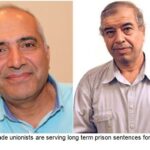
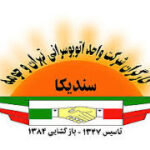


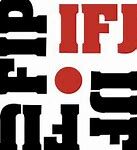
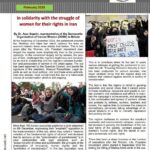


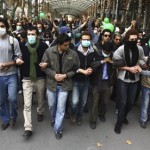
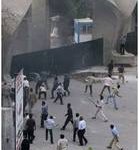
 Posted in
Posted in 